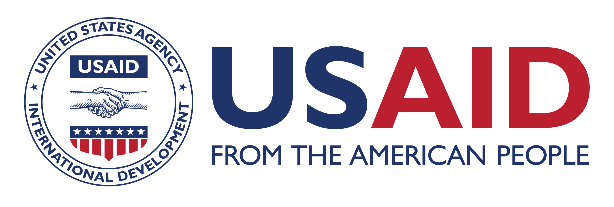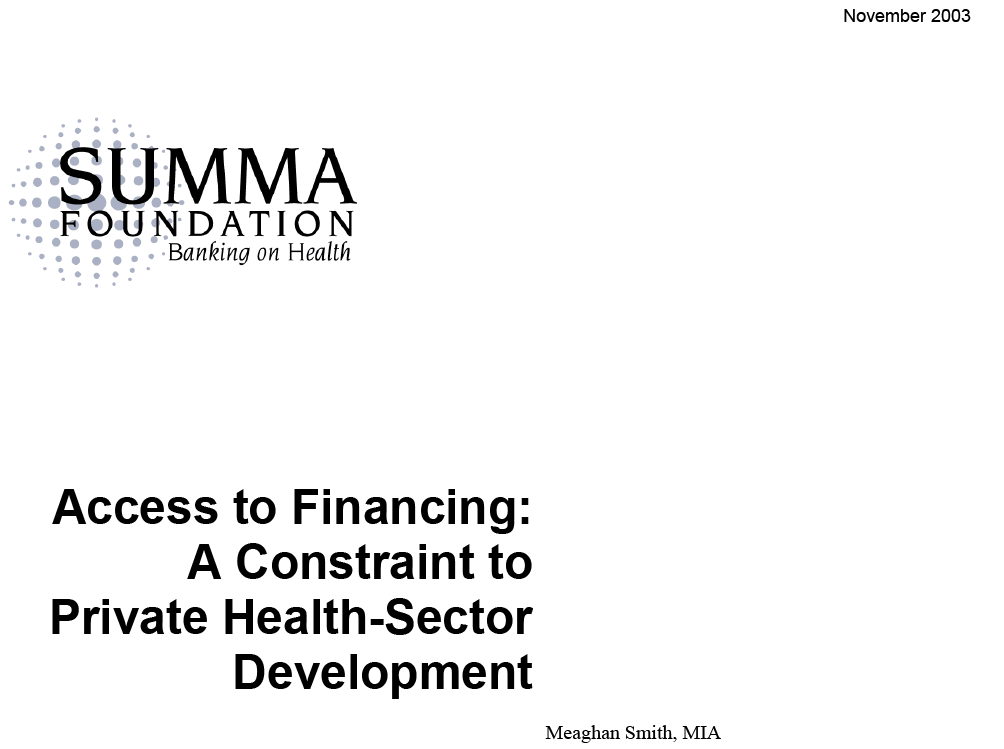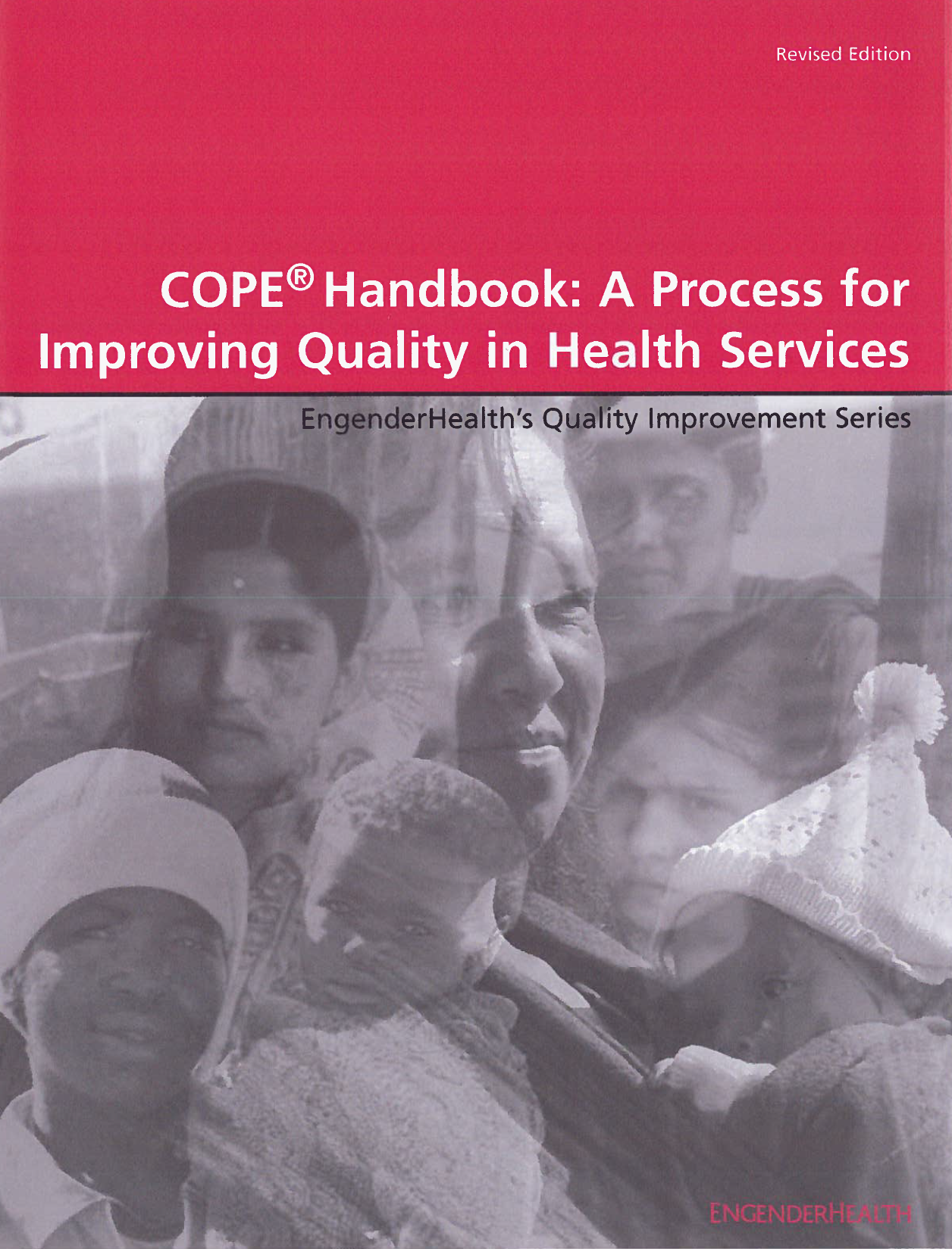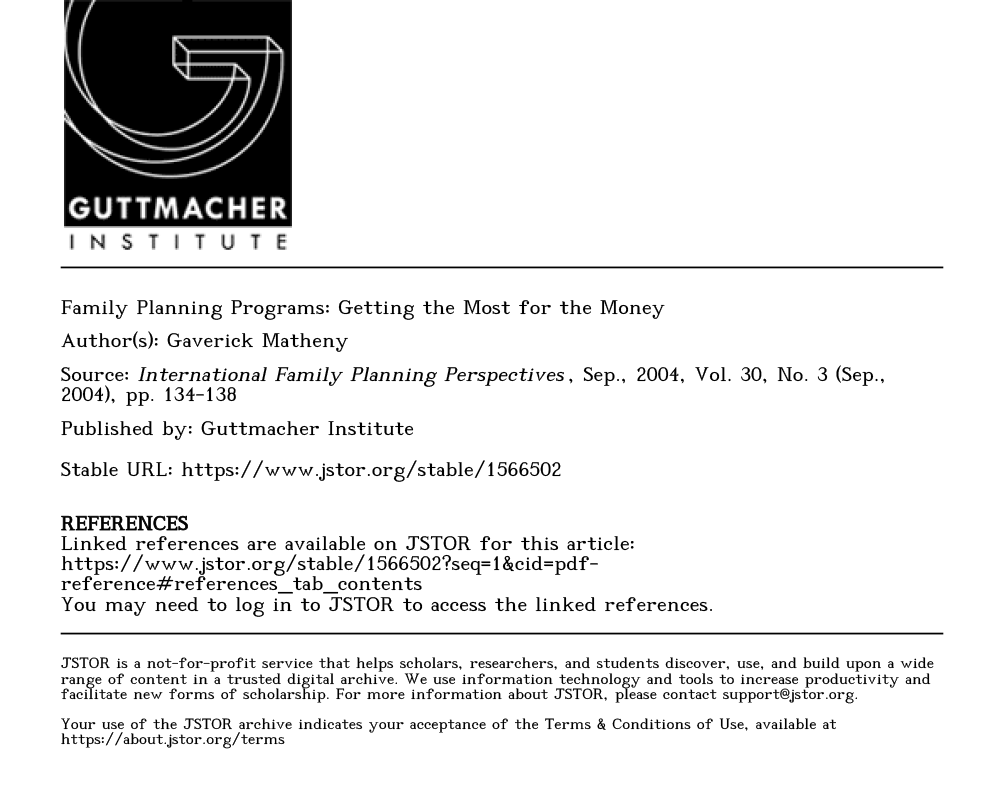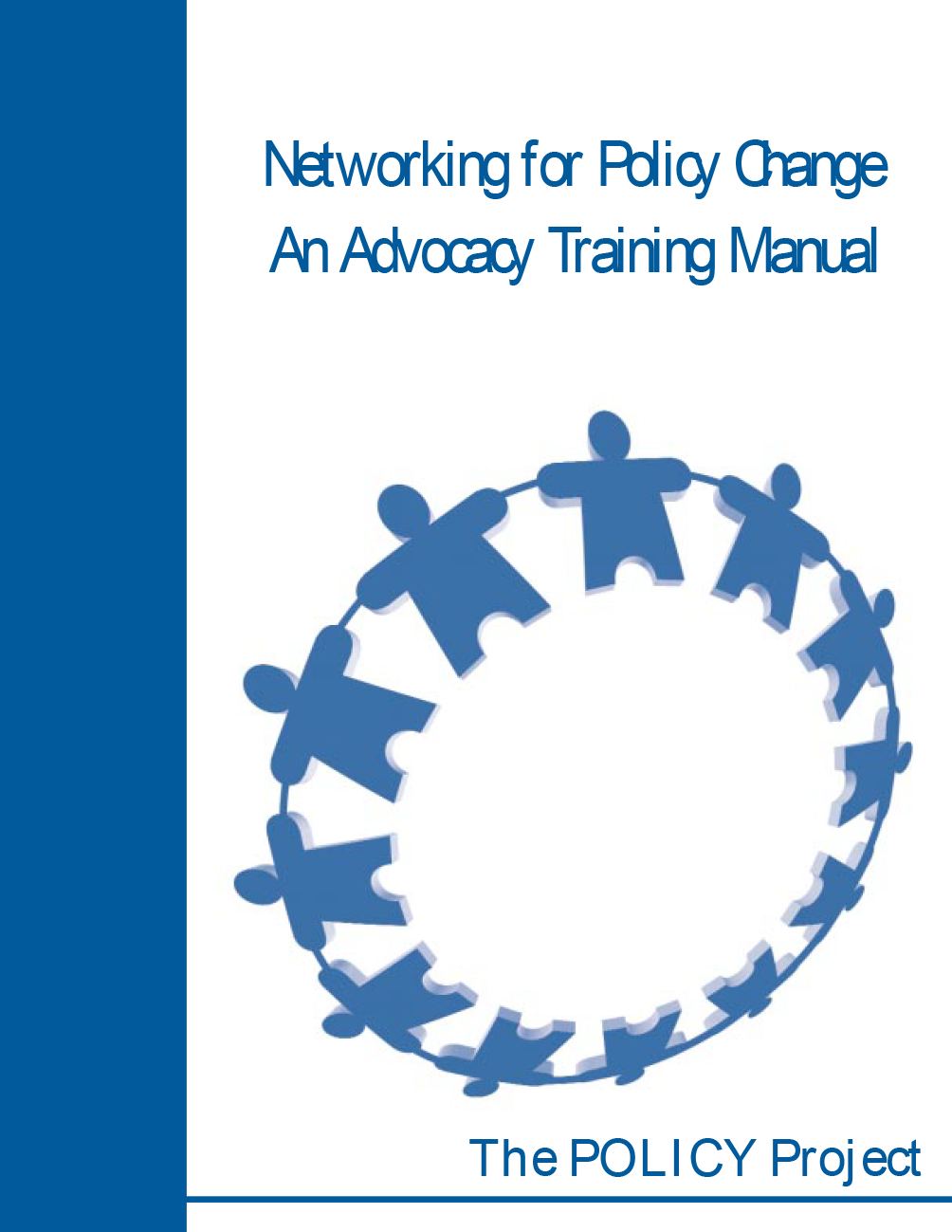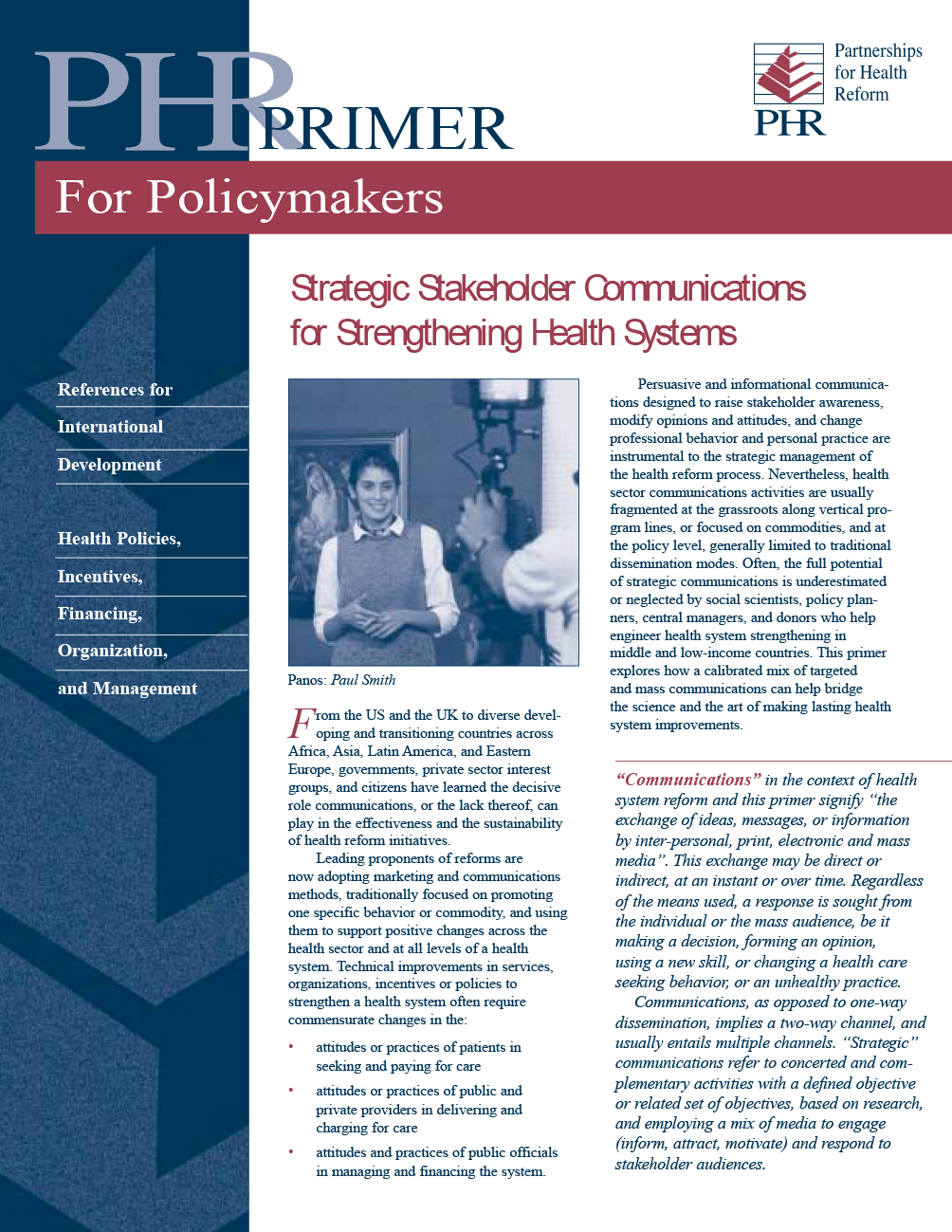
Resource Library
Access to Financing: A Constraint to Private Health-Sector Development
Expanding access to finance is increasingly recognized as a useful tool in working with the private sector. In a climate of limited resources, however, it is important for public health policy makers to assess the magnitude of the financing constraint and to determine the effectiveness of increasing access to finance in improving public health outcomes through the private sector. This paper seeks to inform the policy debate by answering the following questions: Is access to finance a constraint to the development of the private health sector? If the answer is yes, how does lack of finance constrain private-sector development? This paper uses a small and medium enterprise (SME) development framework to answer these questions.
Resource Type : Tool
Country :
Year : 2003-01-01T12:00:00
Language : English
Project : SHOPS

Resource Library
Franchising of Health Services in Developing Countries
Grouping existing providers under a franchised brand, supported by training, advertising and supplies, is a potentially important way of improving access to and assuring quality of some types of clinical medical services. While franchising has great potential to increase service delivery points and method acceptability, a number of challenges are inherent to the delivery model: controlling the quality of services provided by independent practitioners is difficult, positioning branded services to compete on either price or quality requires trade-offs between social goals and provider satisfaction, and understanding the motivations of clients may lead to organizational choices which do not maximize quality or minimize costs. This paper describes the structure and operation of existing franchises and presents a model of social franchise activities that will afford a context for analyzing choices in the design and implementation of health-related social franchises in developing countries.
Resource Type :
Country :
Year : 2002-01-01T17:45:00
Language : English
Project : SHOPS

Resource Library
COPE Handbook: A Process for Improving Quality in Health Services
COPE® was pilot-tested in Kenya and Nigeria in 1988 and was then introduced in other countries in Africa and Asia from 1989 through 1994. In 1995, EngenderHealth published COPE: Client-Oriented, Provider-Efficient Services: A Process and Tools for Quality Improvement in Family Planning and Other Reproductive Health Services. This handbook was designed to help clinic and hospital staff improve the quality of their family planning services through more efficient use of resources and improved overall performance. Now used in more than 45 countries worldwide, COPE has been translated into at least 15 languages (Arabic, Bahasa, Bangla, French, Khmer, Malagasy, Mongolian, Nepali, Portuguese, Russian, Spanish, Tagalog, Turkish, Urdu, and Vietnamese). Over the years, service providers have asked that the tools be expanded to include other aspects of health services, such as maternal care, child health, and adolescent reproductive health services. This new edition provides a more comprehensive explanation of how to introduce and sustain the COPE process. This process is applicable to any set of services that the facility wants to explore, with adaptations to the tools as needed. This handbook is intended for use together with different toolbooks, each containing Self-Assessment Guides, a Client- Interview Guide, Client-Flow Analysis forms, and other assessment tools for a particular type of health services.
Resource Type : Tool
Country :
Year : 2003-01-01T15:45:00
Language : English
Project : SHOPS

Resource Library
Family Planning Programs: Getting the Most for the Money
This Viewpoint piece discusses how donors can know how to get the most change in contraceptive prevalence per dollar spent. Some of the issues mentioned are barriers to contraceptive use, price elasticity, and price subsidies. The paper then discusses other activities and areas where further research is needed.
Resource Type : Other
Country :
Year : 2004-09-01T13:00:00
Language : English
Project : SHOPS

Resource Library
Quality of Health Care and its Role in Cost Recovery With a Focus on Empirical Findings About Willingness to Pay for Quality Improvements
This paper looks at the interrelationship of cost recovery and quality improvements in the health sector of developing countries as well as at people's willingness to pay for perceived improvements in health services. Included in this document are in depth literature reviews of five major types of studies: facility based studies of the effect of cost recovery on utilization, econometric health care demand studies, hedonic pricing studies, contingent valuation studies, and cost-recovery intervention studies. By reviewing these studies, the paper provides a conceptual framework within which one can consider people's willingness to pay for quality improvements in health care by looking at how demand behavior interacts with supply, especially in terms of promoting the financial sustainability of government services. This paper also presents a preliminary design of possible field research activities.
Resource Type : Other
Country :
Year : 1993-12-01T12:45:00
Language :
Project : SHOPS

Resource Library
Keystone Module Background Paper: Private Participation in Health Services Handbook
Attitudes toward private health care providers in developing countries are changing. Growing numbers of policymakers are considering or attempting to incorporate private facilities and practitioners into overall sector policy, using methods such as contracting, training of private practitioners, integration into public referral networks, etc. Unfortunately, these efforts are infrequently recorded, making it difficult for policymakers to learn from the experience of others. Rigorous evaluation of these efforts is rarer still, making it difficult, even perilous, to establish guidelines about such policies. It is possible, however, to review options for enhancing health sector policies related to private service provision, and this paper will do so. The purpose of the review is to familiarize policymakers and sector experts with the full range of policies for enhancing the contributions of private health care providers, both for-profit and non-profit, to sector objectives. Since the objective of this Handbook is to support analysis that feeds into operational policy, attention is focused on this level, avoiding lengthy discussions of theoretical or other more academic issues. This Introductory paper is intended to be comprehensive in nature. Users seeking more detailed information about specific strategies and instruments are referred to subsequent papers in the Handbook.
Resource Type : Tool
Country :
Year : 2001-06-08T09:45:00
Language :
Project : SHOPS

Resource Library
Networking for Policy Change: An Advocacy Training Manual
It is through advocacy—a set of targeted actions in support of a specific cause— that a supportive and self-sustaining environment for family planning and reproductive health goals can be created. This training manual was prepared to help representatives of nongovernmental organizations (NGOs) and other formal groups of civil society form and maintain advocacy networks and develop effective reproductive health/family planning (RH/FP) advocacy skills. The manual's tools and approaches can be used to affect RH/FP policy decisions at the international, national, regional, and local levels.
Resource Type : Tool
Country :
Year : 1999-10-01T18:15:00
Language : English
Project : SHOPS

Resource Library
Making a Difference to Policies and Programs: A Guide for Researchers
This booklet is a guide for researchers who aim to have an impact on policy and program decisions. It is intended for researchers attached to government services and researchers located in academic institutions, as well as researchers working as consultants in the private sector. The approach presented here is designed to help seasoned researchers to achieve greater impact from their own work. The Guide also can be used as a teaching tool with students and younger colleagues. In addition, the Guide should help relatively new researchers to select research questions and conduct studies with program and policy relevance. Although the examples used for illustration purposes are drawn mainly from the health sector in Africa, we hope that researchers working in other sectors and in other regions of the world will find useful ideas in the Guide.
Resource Type : Other
Country :
Year : 1997-07-01T18:00:00
Language :
Project : SHOPS

Resource Library
Strategic Stakeholder Communications for Strengthening Health Systems
Persuasive and informational communications designed to raise stakeholder awareness, modify opinions and attitudes, and change professional behavior and personal practice are instrumental to the strategic management of the health reform process. Nevertheless, health sector communications activities are usually fragmented at the grassroots along vertical program lines, or focused on commodities, and at the policy level, generally limited to traditional dissemination modes. Often, the full potential of strategic communications is underestimated or neglected by social scientists, policy planners, central managers, and donors who help engineer health system strengthening in middle and low-income countries. This primer explores how a calibrated mix of targeted and mass communications can help bridge the science and the art of making lasting health system improvements.
Resource Type : Other
Country :
Year : 2001-03-01T17:45:00
Language : English
Project : SHOPS

Resource Library
Working with Private Providers to Improve the Delivery of Priority Services
Developing a strategic mix of private and public provision of health services in order to achieve health reform objectives can be complex. Policymakers may wonder about what private providers could contribute to public health goals. The decision to collaborate with the private sector depends on whether working with the private sector offers a more cost-effective way to achieve health objectives than other interventions involving public providers. Private sector financing of health care is an integral component of developing country health systems. Private financing may include payments by individuals for pharmaceuticals and hospital stays, employer reimbursement for employees' healthcare costs, and other forms of private payments for healthcare. These types of payments may actually be paid to public sector health facilities. Encouraging private financing to supplement limited government funds is an important strategy in addressing budgetary issues. While it is difficult to separate service delivery and financing issues, this primer focuses more on the public-private service delivery mix rather than on the public-private financing mix. The purpose of this primer is to provide a conceptual framework for policymakers who are considering how best to strengthen the delivery of priority services by working with the private sector.
Resource Type :
Country :
Year : 2001-03-01T17:15:00
Language : English
Project : SHOPS
Pagination
- Previous page
- Page 13
- Next page

